
Llano County is a county located on the Edwards Plateau in the U.S. state of Texas. As of the 2020 census, its population was 21,243. Its county seat is Llano, and the county is named for the Llano River.

Kendall County is a county located on the Edwards Plateau in the U.S. state of Texas. In 2020 census, its population was 44,279. Its county seat is Boerne. The county is named for George Wilkins Kendall, a journalist and Mexican–American War correspondent.

Boerne is a city in and the county seat of Kendall County, Texas, United States, in the Texas Hill Country. Boerne is known for its German-Texan history, named in honor of German author and satirist Ludwig Börne by the German Founders of the town. The population of Boerne was 10,471 at the 2010 census, and in 2020 the population was 17,850. The city is noted for the landmark U.S. Supreme Court case City of Boerne v. Flores. Founded in 1849 as "Tusculum", the name was changed to "Boerne" when the town was platted in 1852.

Cleng Peerson was a Norwegian emigrant to the United States; his voyage in 1824 was the precursor for the boat load of 52 Norwegian emigrants in the following year. That boat load was a precursor for the main wave of Norwegian immigration to the United States.
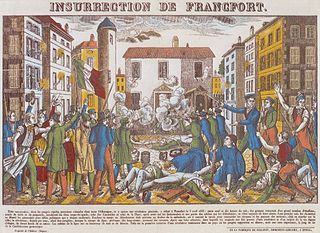
The Frankfurter Wachensturm on 3 April 1833 was a failed attempt to start a revolution in Germany.
August Siemering was a notable German Texan educator, writer, publisher and political leader.
Castell is a small unincorporated, rural town in Llano County, Texas, United States. It is part of the Texas German belt region, and most residents are still ethnic German-Texan. Its population was 104 at the 2010 census. Located in the heart of the Texas Hill Country, its northern border is formed by the Llano River. It was designated a Recorded Texas Historic Landmark in 1964, marker number 9440.
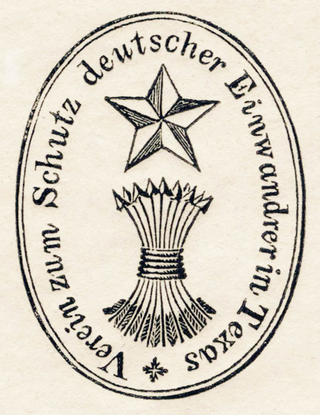
The Mainzer Adelsverein at Biebrich am Rhein, better known as the Mainzer Adelsverein, organized on April 20, 1842, was a colonial attempt to establish a new German settlement within the borders of Texas.

Gustav Philipp Koerner, also spelled Gustave or Gustavus Koerner, was a German-American revolutionary, journalist, lawyer, politician, judge and statesman in Illinois and Germany, and a Colonel of the U.S. Army who was a confessed enemy of slavery. He married on 17 June 1836 in Belleville Sophia Dorothea Engelmann ; they had 9 children. He belonged to the co-founders and was one of the first members of the Grand Old Party, and was a close confidant of Abraham Lincoln and his wife Mary Todd, and had an essential role in his nomination and election for president in 1860.

Sisterdale is an unincorporated farming and ranching community established in 1847 and located 13 miles (21 km) north of Boerne in Kendall County, in the U.S. state of Texas. The community is located in the valley of Sister Creek. The elevation is 1,280 feet (390 m).
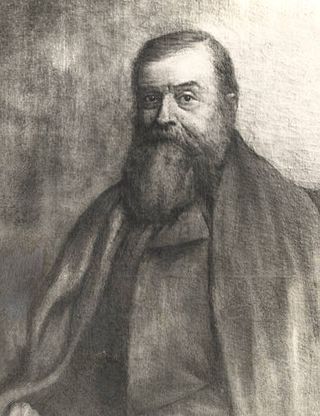
Ferdinand Ludwig Herff (1820–1912) was a 19th-century German-born physician who emigrated to Texas and became a medical pioneer in San Antonio. He was one of the co-founders of the Bettina commune. In 1982, Recorded Texas Historic Landmark 1268 was placed on Malakopf Mountain in Boerne, to honor Herff. His homesite in San Antonio was designated a Recorded Texas Historic Landmark in the year 2000, Marker number 12345.
Hermann Spiess was co-founder of the Bettina, Texas commune in 1847. He became Commissioner-General of the Adelsverein after the resignation of John O. Meusebach.
Ottomar von Behr was a meteorologist and naturalist, who became an Adelsverein colonist in Texas. He was the second settler at Sisterdale, Texas, and the person who gave the town its name.

Welfare is an unincorporated community 4 miles (6 km) southeast of Waring on the Waring-Welfare Road in west-central Kendall County, in the U.S. state of Texas. The school was designated a Recorded Texas Historic Landmark in 2000.
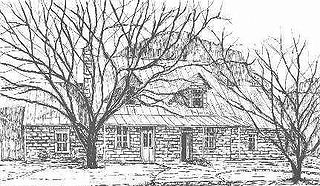
Nicolaus Zink (1812–1887) was the founder of Sisterdale, Texas, and builder of the fort Zinkenburg. Under the direction of Prince Carl of Solms-Braunfels, Zink led a caravan of new settlers from Indianola to New Braunfels. He laid out the town and divided the original allotted farm acreage. In 1984, the Zink house in Welfare, Texas, was designed a Recorded Texas Historic Landmark, marker 3595.

The Fisher–Miller Land Grant was part of an early colonization effort of the Republic of Texas. Its 3,878,000 acres covered 5,000 square miles (13,000 km2) between the Llano River and Colorado River. Originally granted to Henry Francis Fisher and Burchard Miller, the grant was sold to the German colonization company of Adelsverein. Very few colonizations resulted from the land grant, as most settlers preferred Fredericksburg and New Braunfels, which lay outside the land grant boundaries. A granite monument located near Lookout Mountain in Burnet County summarizes the history and importance of the Fisher-Miller Land Grant and was designated as a Recorded Texas Historic Landmark in 1964, Marker number 9438.
Emil Kriewitz was a German immigrant and veteran of the Mexican–American War, who came to this country with the Adelsverein colonists. After John O. Meusebach successfully negotiated the Meusebach–Comanche Treaty, Kriewitz lived among the Penateka Comanche as an intermediary between the whites and Penateka. In 1993, his home in Castell, Texas, was designated a Recorded Texas Historic Landmark, Marker number 9444.
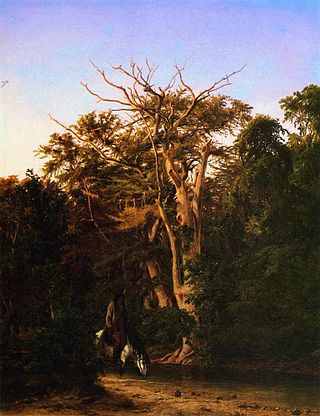
The Pinta Trail is a historic trail in Central Texas that was first traveled by indigenous tribes, and later explorers, settlers, soldiers, and travelers. The 19th-century Germans who settled the Texas Hill Country used part of the Pinta Trail on their journey northward from New Braunfels to found Fredericksburg. A historic battle between a Texas Rangers patrol and a band of Comanches is often said to have occurred near a ford where the Pinta Trail crossed the Guadalupe River.
Bettina is a vanished community founded in 1847 by German immigrants as part of the Adelsverein colonization of the Fisher–Miller Land Grant in the U.S. state of Texas. It was located on the banks of the Llano River in Llano County, and no trace of the settlement remains today. The community was named after German artist and social activist Bettina von Arnim and was one of five attempted by the Darmstadt Forty. It was also known as the Darmstaedter Kolonie. The community was sponsored by the Adelsverein, and founded on idealistic philosophies of European freethinkers of the day. It is notable for the community's camaraderie and mutually respectful relations with local indigenous tribes. Lack of a formal community framework caused Bettina to fail within a year of its founding.













